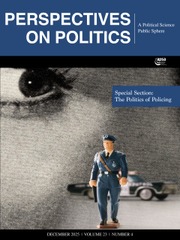I am grateful for Kaitlin N. Sidorsky and Wendy J. Schiller’s thoughtful response to Intersectional Advocacy. I am excited to be in conversation with them about the book’s application to the 2022 VAWA reauthorization and how the intersectional advocates I studied approached criminal justice policies.
I completed the data collection for this book in early 2021 and was therefore unable to collect and analyze data on the 2022 VAWA reauthorization for this text. However, I am enthusiastic that Sidorsky and Schiller find my theory to be applicable in understanding this latest reauthorization of the act. Their observations underscore one of the book’s central themes: the policy achievements won by intersectional advocates are often incremental and iterative. For example, the extension of Special Criminal Jurisdictions to Alaska Tribal Nations shows how advocates take advantage of reauthorization cycles to build on past successes. The closing of the boyfriend loophole vis-a-vis a later statute shortly after the VAWA debate, in turn, shows how iterative processes of policy change can extend beyond reauthorization cycles. While I could not analyze the 2022 reauthorization in this book, I hope that other scholars will take up the theoretical framework I have developed to study this and future iterations of VAWA reauthorization as well as other policy processes.
In their review, Sidorsky and Schiller note that bail hearings can offer opportunities to remove firearms from abusers and ask if the organizational leaders I encountered addressed this issue in their congressional testimonies. Rather than return to the testimonies here (although I encourage other scholars to do so), I take this question as an opportunity to reflect on how intersectional advocates pursued policies in response to criminal justice. For many of these advocates, VAWA has never been an optimal site to achieve their political goals, given its connections to crime control policy. These advocates encounter the harmful effects of crime policy in their work, which includes advocacy on the federal, state, and local levels. Given their broad perspective, the organizations in this book are attuned to the harmful effects of many pretrial detention policies on intersectionally marginalized communities. Indeed, one organization I study in the book advocates for ending cash bail because they find it disproportionately impacts Black women who are survivors of violence. They instead pursue non-carceral alternatives (e.g., restorative justice, listening circles, and addressing underlying gender power dynamics) which they see as more promising interventions that could reduce violence without facilitating additional harm to this intersectionally marginalized group.
I believe the reason why intersectional advocates did not address firearm laws in my interviews with them is similar to their reasons for advocacy against carceral punishment altogether. While cash bail hearings do present opportunities for firearm removal, many firearm laws and pretrial detention policies are perceived by these advocates as an expansion of the carceral state. That being said, other types of firearm laws may be able to restrict firearms without risking this entanglement with punitive criminal justice policies. I encourage other scholars to examine how intersectional advocates navigate possible policy alternatives at the nexus of criminal justice and gender-based violence policies. I am grateful to Sidorsky and Schiller for their important work on firearm laws—and their generous reading of Intersectional Advocacy.


